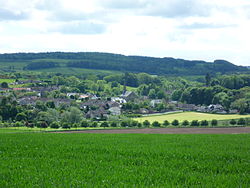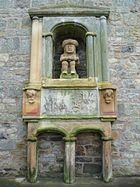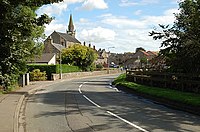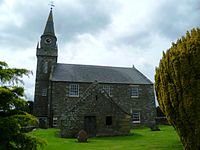Ceres, Fife
| Ceres | |
| Fife | |
|---|---|

| |
| Location | |
| Grid reference: | NO400115 |
| Location: | 56°17’32"N, 2°58’13"W |
| Data | |
| Population: | 1,019 (2001) |
| Post town: | Cupar |
| Postcode: | KY15 |
| Dialling code: | 01334 |
| Local Government | |
| Council: | Fife |
| Parliamentary constituency: |
North East Fife |
Ceres is a village in Fife, sitting in a small glen some two miles over the Ceres Moor from Cupar and seven miles from St Andrews. The former parish of that name included the settlements of Baldinnie, Chance Inn, Craigrothie, Pitscottie and Tarvit Mill.
Village
The village has a village green known as the "Bow Butts" since its use as an archery practice ground in the Middle Ages. The Ceres Burn runs through the village and alongside the green. An old packhorse bridge, known as the "Bishop's Bridge" has spanned the burn since the 17th century and still stands close to a more modern road bridge.

A feature of the village is its 18th-century statue of "The Provost". It is thought to depict the Rev. Thomas Buchanan (related to the 17th-century theologian George Buchanan), who became the last church provost of Ceres in 1578. The figure portrays him as a toby jug and is possibly satirical. The sculptor, a local stonemason named James Howie, also carved a panel below the figure depicting the Battle of Bannockburn. The sculpture is an amalgam of parts: as the upper section is modelled on a Toby jug it cannot pre-date 1760; the word PROVOST has been added by a different hand and appears to be a joke aimed an intemperate provost. The overall frame is indeed 16th or early 17th century and contains a worn but highly interesting hunting scene.

The village is dominated by the Parish Church. It has what is possibly the shortest High Street in Scotland - just a few houses on each side. In a prominent position by the Bow Butts is a monument commemorating the men of Ceres who fought in the Battle of Bannockburn in 1314. It was erected on the six hundredth anniversary of the battle, in 1914.
The Italian balloonist Vincenzo Lunardi landed in the parish after his first flight hereabouts in 1785. Fetched from a field near Pitscottie, he was greeted in the village where his flag was carried in procession and the church bell rung in his honour.
While agriculture remains important to the local economy, many local residents now commute to work in nearby towns and cities such as Perth, Cupar, Dundee, St Andrews and Glenrothes. A pottery in the village has revived the manufacture of traditional Fife 'Wemyss Ware'.
Folk Museum
The Fife Folk Museum is located in the village in a range of buildings including the old weigh-house[1] where grain was weighed at a tron on market days. The building also served as a tolbooth for locking up minor offenders and the village jougs are still attached. The museum commemorates rural life of a bygone era. The museum began in 1968 in the renovation and conversion[2] of the former weigh-house and adjoining cottages through an initiative by Cupar & North Fife Preservation Society.
Origin of the name
Various suggestions have been made as to the origin of the village's name.
Ceres was the Roman goddess of agriculture and grain, and so may have been suggested for a farm here, or an older name may have been given a spelling after the Roman pattern. The name may though signify "place to the west" from the Scottish Gaelic Siar meaning "west", in relation to St Andrews Locational endings in -es are common in East Fife.
Suggestions that the name originated from an early dedication of the local kirk, such as to "Saint Siris", Saint Cyrus or Saint Cyricus have been discounted.[3]
It has also been posited that the name 'Ceres' is derived from the Norse syr reit, meaning 'enclosure for swine'.[4]
Ceres Games
The Ceres Games are said to have been held every year since 1314 after Robert the Bruce granted the village permission to hold them in commemoration of its men's participation in the Battle of Bannockburn. Now staged in the form of Highland games, they are the oldest free games in Scotland.[5]
Craighall
Craighall stands about three-quarters of a mile south-east of the village; it was the historic seat of the Hope family.
Parish church

The current parish church was built in 1806 to a design by Alexander Leslie, replacing a mediæval building. A tower and octagonal spire were added in the 1850s. Apart from the addition of electric lighting and two early 20th-century stained glass windows (either side of the central pulpit), the interior is substantially unaltered from when first built and retains the gallery and original wooden box pews.[6]
Within the vestibule of the church a late mediæval effigy of a knight which was originally in the ancient church is preserved on a modern stand. It is extremely well preserved and shows interesting details of 15th-century armour.
There is a mausoleum in the cemetery which was established by the widow of Robert 9th Lord Lindsay and is called "Lady Boyd's House" as she subsequently married the 6th Lord Boyd of Kilmarnock. However, the vault contains the grave of John Lindsay, 20th Earl of Crawford (1702-1749).
The church within the Church of Scotland's Presbytery of St Andrews. In 1983, the parish of Ceres was linked (and later united) with the neighbouring parish of Springfield, which in turn became united with Kemback in 2005, although the three church buildings are retained.
Outside links
| ("Wikimedia Commons" has material about Ceres, Fife) |
References
- ↑ "Ceres, High Street, Fife Folk Museum". Canmore. Historic Environment Scotland. https://canmore.org.uk/site/33058/ceres-high-street-fife-folk-museum.
- ↑ "DSA Building/Design Report: Fife Folk Museum". Dictionary of Scottish Architects. http://www.scottisharchitects.org.uk/building_full.php?id=401019.
- ↑ Taylor: The Place Names of Fife Volume Two (Shaun Tyas, 2008).
- ↑ Liddall, W.M.: 'The Place Names of Fife and Kinross' (Wm Green & Sons, 1896)
- ↑ Ceres Highland Games
- ↑ Churches to Visit in Scotland, 2000-01 edition, published for the Scottish Churches Scheme by the St Andrew Press, Edinburgh, ISBN 0-86153-291-0
